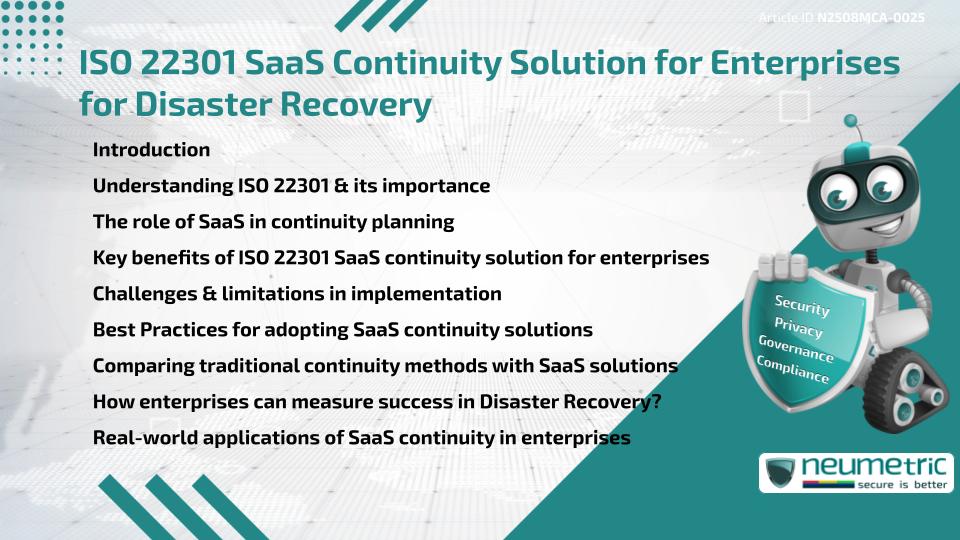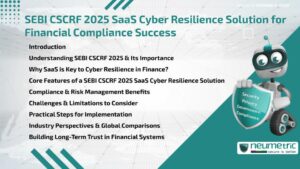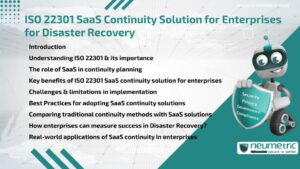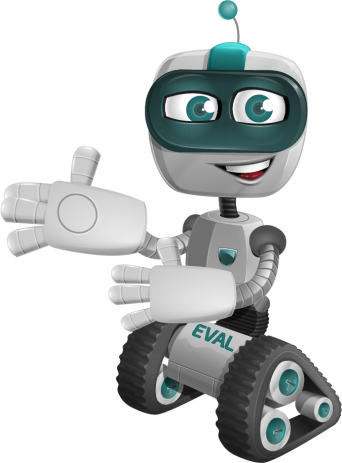Table of Contents
ToggleIntroduction
An ISO 22301 SaaS continuity solution for enterprises offers a robust way to ensure Disaster Recovery & maintain Business Operations without interruption. Built on the foundation of the International Standard ISO 22301, it provides structured continuity strategies through cloud-based platforms that reduce downtime, mitigate Risks & streamline compliance. Enterprises benefit from faster recovery times, scalable infrastructure & simplified management of continuity processes. This approach is especially critical when dealing with disruptions like cyberattacks, system failures or natural disasters. By combining ISO 22301’s Framework with SaaS flexibility, enterprises can maintain resilience & safeguard both operations & reputation.
Understanding ISO 22301 & its importance
ISO 22301 is the International Standard for Business Continuity Management. It defines requirements for establishing, implementing & improving a management system that prepares Organisations for disruptions. For enterprises, aligning with ISO 22301 ensures a systematic approach to resilience. It emphasises Risk Assessment, response planning & continual improvement. Without such a Framework, Organisations may face prolonged downtime & reputational damage after a disaster.
The role of SaaS in continuity planning
SaaS platforms provide enterprises with cost-effective, cloud-based tools to support continuity management. Instead of investing heavily in physical infrastructure, Organisations can leverage SaaS for data replication, automated backups & real-time monitoring. The pay-as-you-go model makes it easier for enterprises to scale according to their needs. SaaS also ensures accessibility, as Employees can continue working from any location during a crisis, provided there is Internet connectivity.
Key benefits of ISO 22301 SaaS continuity solution for enterprises
Adopting an ISO 22301 SaaS continuity solution for enterprises offers several distinct benefits:
- Scalability: Easily adjust resources based on workload & operational demands.
- Cost Efficiency: Avoid large upfront investments in hardware & infrastructure.
- Compliance: Ensure that continuity practices meet the requirements of ISO 22301.
- Rapid Recovery: Minimise downtime with automated Disaster Recovery features.
- Accessibility: Enable remote teams to access continuity tools & resources during crises.
Challenges & limitations in implementation
While SaaS-based continuity offers many advantages, it also presents challenges. Data Security remains a top concern, as Sensitive Information is stored in Third Party environments. Dependency on Internet connectivity can hinder continuity during widespread network outages. Enterprises must also carefully evaluate vendors to ensure long-term reliability & compliance with legal requirements. In some cases, hybrid models combining on-premises & SaaS solutions may provide a more balanced approach.
Best Practices for adopting SaaS continuity solutions
Enterprises can maximise the effectiveness of SaaS continuity solutions by:
- Conducting a Risk Assessment aligned with ISO 22301.
- Evaluating Vendor Credentials & Certifications.
- Testing Disaster Recovery plans through regular drills.
- Training Employees to respond effectively to disruptions.
- Monitoring Compliance with Regulatory requirements.
Comparing traditional continuity methods with SaaS solutions
Traditional continuity planning often involves building & maintaining dedicated data centers, which requires significant Financial & staffing resources. SaaS continuity solutions eliminate much of this overhead by offering virtualised, on-demand resources. Unlike static, hardware-based methods, SaaS models allow real-time adaptability. However, traditional methods may still be preferred in highly regulated industries where data sovereignty is critical.
How enterprises can measure success in Disaster Recovery?
Measuring the success of an ISO 22301 SaaS continuity solution for enterprises requires clear performance indicators. Common metrics include Recovery Time Objectives [RTO], Recovery Point Objectives [RPO] & the percentage of processes restored within acceptable timeframes. Continuous Monitoring & audits help enterprises evaluate whether the solution meets both regulatory & operational goals.
Real-world applications of SaaS continuity in enterprises
Enterprises across industries use SaaS continuity platforms to maintain operations during disruptions. For instance, Financial Services leverage these solutions for secure data backup & compliance reporting. Healthcare Organisations use them to ensure Patient Data availability during system outages. Manufacturers depend on SaaS platforms to keep supply chain operations functional when physical facilities are impacted. These examples demonstrate the adaptability & relevance of SaaS continuity solutions across diverse sectors.
Conclusion
An ISO 22301 SaaS continuity solution for enterprises delivers a structured & reliable path to Disaster Recovery. By uniting ISO 22301’s Business Continuity Framework with the scalability of SaaS, Organisations gain both resilience & cost efficiency. Though challenges such as security & vendor reliance exist, the overall benefits make SaaS solutions a vital component of enterprise Disaster Recovery strategies.
Takeaways
- ISO 22301 establishes a recognised Standard for Business Continuity.
- SaaS provides cost-effective, scalable & accessible continuity tools.
- Combining both enhances Disaster Recovery for enterprises.
- Success depends on careful vendor selection, testing & monitoring.
FAQ
What is ISO 22301?
ISO 22301 is the International Standard for Business Continuity Management that helps Organisations prepare for & recover from disruptions.
Why should enterprises choose an ISO 22301 SaaS continuity solution for enterprises?
It combines ISO 22301’s structured Framework with SaaS flexibility, allowing faster recovery & cost efficiency.
What are the main benefits of SaaS continuity solutions?
Key benefits include scalability, compliance, rapid recovery, accessibility & cost savings.
Are there Risks with SaaS continuity solutions?
Yes, Risks include Data Security concerns, reliance on Internet connectivity & vendor stability.
How can enterprises ensure compliance with ISO 22301?
By conducting audits, regular training & aligning continuity Policies with the requirements of the ISO 22301 standard.
Do SaaS solutions replace traditional continuity methods?
Not always. In some industries, hybrid approaches that combine SaaS with on-premises systems are more effective.
How do enterprises test their continuity plans?
They can run simulations, tabletop exercises & full-scale Disaster Recovery drills to evaluate readiness.
Need help for Security, Privacy, Governance & VAPT?
Neumetric provides organisations the necessary help to achieve their Cybersecurity, Compliance, Governance, Privacy, Certifications & Pentesting needs.
Organisations & Businesses, specifically those which provide SaaS & AI Solutions in the Fintech, BFSI & other regulated sectors, usually need a Cybersecurity Partner for meeting & maintaining the ongoing Security & Privacy needs & requirements of their Enterprise Clients & Privacy conscious Customers.
SOC 2, ISO 27001, ISO 42001, NIST, HIPAA, HECVAT, EU GDPR are some of the Frameworks that are served by Fusion – a SaaS, multimodular, multitenant, centralised, automated, Cybersecurity & Compliance Management system.
Neumetric also provides Expert Services for technical security which covers VAPT for Web Applications, APIs, iOS & Android Mobile Apps, Security Testing for AWS & other Cloud Environments & Cloud Infrastructure & other similar scopes.
Reach out to us by Email or filling out the Contact Form…





